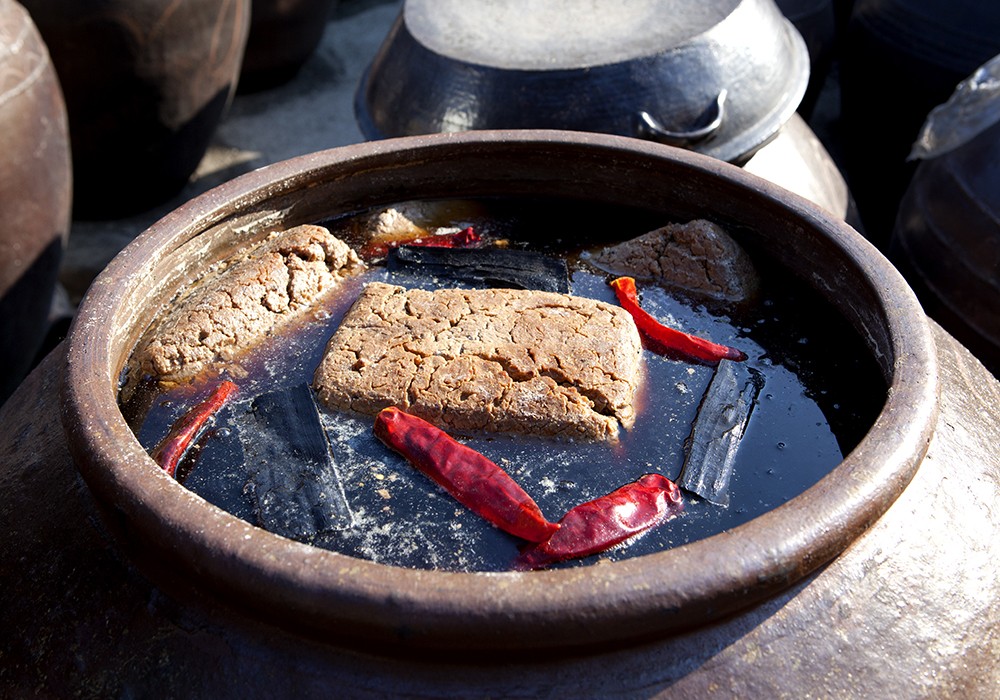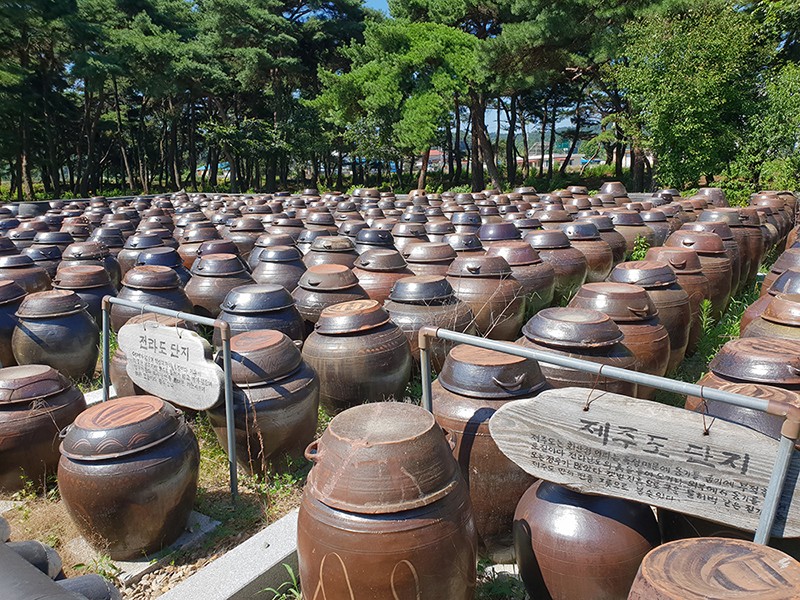한식 읽기 좋은 날
Vol 52. Soil, the Foundation of HANSIK
Older than the United States: The Centuries-old Secret of Ssiganjang
Facts about HANSIK
There is a growing number of people who are interested in ssiganjang, whose dictionary definition is “aged soy sauce that is included when making new soy sauce.” Ancient Koreans saved a certain amount of well-ripened soy sauce to add to next year’s new batch, thereby ensuring uniformity of taste and fragrance. In other words, ssiganjang is a medium for passing down delicious soy sauce from one generation to the next, allowing us to appreciate the same flavors that were enjoyed by people who lived long before.
Article Yim Kyungsook (president, KFPI) (previously published in June issue of JoongAng Ilbo's Cooking magazine)

Interest in ssiganjang among domestic and foreign consumers
One famous anecdote about ssiganjang is related to a dinner banquet that was held in 2017 for US President Donald Trump’s state visit to Korea. The main dish was grilled Korean beef ribs. What was noted by the international press was the 360-year-old ssiganjang that was used for the sauce.
Most of the press coverage focused on the fact that the ssiganjang is older than the history of the US. It was provided by the head family of the Jangheung Koh clan of Damyang-gun, Jeollanam-do Province, which is actually frequented by chefs from all over Korea and other countries just to taste its famous ssiganjang.
There is also an anecdote about the head family of the Boseong Seon clan (of Boeun, Chungcheongbuk-do Province), which was invited to the Korea Antiques Food Art Fair that was held in 2006 in Seoul’s Insadong district. At the event, the chairman of a Korean conglomerate purchased one liter of the Boseon Seon clan’s
ssiganjang for KRW 5 million—which works out to about KRW 100 million for one earthenware jar. This story has been told repeatedly over the years to show how valuable ssiganjang is in the world of Korean food.

Korea's unique culture of deotjang
It is not an overstatement to say that jang is the foundation of Korean cuisine. The most basic is ganjang (soy sauce), which is used in many different dishes and named slightly differently depending on how long it has been fermented. Newly-made soy sauce is called haetganjang, while all other types are classified by the number of years they were fermented (cheongganjang: one to two years, jungganjang: three to four years, and jinganjang: five or more years).
With time, two substances grow in number: bacteria/mold/yeast, which affects how the soy sauce ferments, and free amino acids, which are responsible for soy sauce's savory flavor. Ssiganjang refers to the best of a family's jinganjang that has been passed down for generations. Serving as the base of any dish for which it is used (ssi means “seed” in Korean), ssiganjang is a deep dark brown and offers a special blend of salty and sweet.
Korean soy sauce is stored in an earthenware container called a jangdok. The jangdok is made from clay and, therefore, breathable: this does not mean, however, that its breathability automatically guarantees well-ripened soy sauce. During the day, the lid must be kept off to allow access to sunlight (which kills miscellaneous germs and bacteria). At night, the jangdok must be covered to keep moisture out. In pre-modern Korea, the task of maintaining the flavor and quality of a household's soy sauce was carried out with great care. The way a family’s food tasted was largely determined by its jang: if the flavors were successfully passed down for several generations, it was a source of great pride.
This begs the question: how does ssiganjang survive hundreds of years in active use? The secret is to add a little bit of newly-made soy sauce each year in a practice known as deotjang. Soy sauce stored in an earthenware pot dwindles over time for two reasons: 1) when used for cooking and 2) due to the evaporation of water because of the earthenware pot's breathability. By adding a small amount of haetjangjang each year, the flavor—and quantity—of the ssiganjang can be maintained.
Korea’s use of ssiganjang and deotjang are not found anywhere else in the world, including in China and Japan, both of which use soy sauces that are similar to the Korean version. In recognition of the need to protect the cultural value of jang, in 2018, the Cultural Heritage Administration (CHA) designated “Jang Damgeugi (Korean Sauce and Paste Making)” as National Intangible Cultural Heritage No. 137.
The Ministry of Agriculture, Food and Rural Affairs and the KFPI, encouraged by this development, helped the CHA with the paperwork required to register Korea's jang culture as a UNESCO Intangible Cultural Heritage—an effort that began in 2014. The KFPI is now waiting for UNESCO to announce its decision, which is expected to be posted in December 2024.

The beauty of slow food through traditional soy sauce
In recent years, the public has definitely become more interested in ssiganjang. The reality remains, however, that the vast majority of households do not make soy sauce, let alone ssiganjang, at home. In a 5G-driven world that prioritizes speed, for the many who live in apartment buildings without a balcony (where earthenware jars would be kept) and are accustomed to ordering food via delivery apps, making soy sauce is a challenge that they have never considered.
The good news, however, is that with a little bit of effort, apartmentdwellers can make their own traditional soy sauce right at home. Meju (soybean blocks), which is difficult to make in an apartment flat, can be ordered online. The rest of the process is actually quite simple. Clean the meju with a brush and air-dry it. After preparing salt water at a 1:3 ratio (organic salt : water), pour it into the earthenware pot that the meju has been placed in. The meju must be completely submerged in the salt water because exposure to air can result in rotting.
After adding charcoal, dried peppers, and jujubes, wait for 60 to 90 days. Break apart the meju with your hands to get doenjang (soybean paste), with the remaining liquid being soy sauce. A supply of well-ripened soy sauce at one’s disposal results in a significant improvement in the quality of home-cooked meals.
Homemade soy sauce is useful not only for steamed and braised dishes (e.g. sogogi jangjorim (soy sauce-braised beef), galbijjim (braised beef ribs), bulgogi (barbequed beef), ganjang gyejang (soy sauce-marinated crab)) but also when pickling kkaetnip (perilla leaves), garlic stems, or onions. Another lesser-known use of soy sauce is as a tea-like beverage. Adding hot water to soy sauce reduces the saltiness while amplifying its natural flavors.

 한국어
한국어
 English
English






